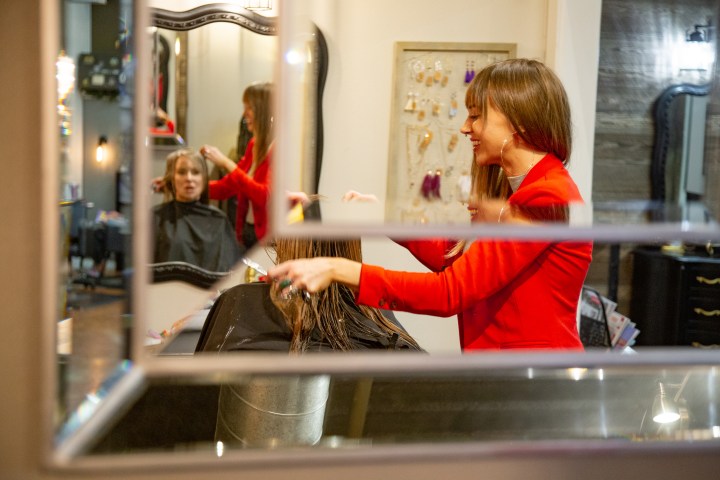
We talked to 10 people who roughly represent the 164 million-person U.S. labor force. Ten stories, one question: “Is the economy working for you?” Meet Ashley.
- Name: Ashley Nelson
- Occupation: Licensed cosmetologist, The Collab Salon
- Based in: Boise, Idaho
- Daily commute: An 8-mile, 16-20 minute drive
- Age: 34
The numbers on Ashley:
- The Bureau of Labor Statistics would categorize Ashley’s job as a “service occupation” along with medical assistants, police officers, lifeguards, chefs, waiters, janitors, travel guides and a wide range of other workers. Two in 10 people in the U.S. labor force work jobs in that category.
- Like about 80% of the U.S. labor force, Ashley works full time.
At age 20, Ashley moved from Northern California to Boise, Idaho, to save money on cosmetology school. Nearly 15 years later, it’s still the city she calls home. After becoming a licensed hair stylist, she put in long hours in the salon, waiting for walk-ins so that she could start building up a clientele. Boise has changed a lot since Ashley moved there — it’s one of the fastest-growing metropolitan areas in the country. She’s seen new people move in, rent rise and traffic increase. Boise’s growing economy has also provided Ashley with opportunity. These days, many of her clients are what she calls “C-class” clients, meaning, CEOs, CFOs and other high-income individuals.
What kind of training did you have to do to get the job you have now?
To become a stylist, I had to complete hair school. I moved from California to Idaho because it was about $10,000 cheaper there than in San Francisco where I was living. I opted for a small, independent cosmetology school where I spent 40 hours a week training for a year. I finished 2,000 hours and had to take a written and practical exam to get my license. I realize most of the education came from hard work and dedication behind the chair.
What’s the one tool you can’t do your job without?
When I think of the one “tool” that comes to mind that I can’t do my job without my first thought was “the people.” If there are not bodies in my chair, I don’t have a canvas to work on. I also can’t do my job without my hands. So a working body is the most important part of being able to perform my job. But if I had to pick a physical tool, I would have to pick my shears.
What’s the hardest part about your job that nobody knows?
As a hairstylist, you’re an artist, but you also have to be a businesswoman/man. There are business-related things you have to know to be successful as a tradesperson. I am creating art on someone’s head, working as fast as possible, while holding a conversation. Then, after all that pampering and creating, I go home and crunch numbers. It’s hard to find work-life balance with all the things outside the salon that take time that you don’t get paid for like staying ahead of styles and trends. That’s why it’s so important to charge your worth. Being business savvy is just as important as being an artist.
When you were a kid, what job did you think you were going to have when you grew up?
As a child, I always knew I wanted to do hair. I remember wrapping fake perms on my grandma and hearing how cheap it was for her to go to hair school when she was young. I still have her old cosmetology books. I told my dad I wanted to do hair when I was older and he said, “Well, you’ll always have a job, people will always want to get their hair done.”
Click the media players below to hear how Ashley’s story evolved:
There’s a lot happening in the world. Through it all, Marketplace is here for you.
You rely on Marketplace to break down the world’s events and tell you how it affects you in a fact-based, approachable way. We rely on your financial support to keep making that possible.
Your donation today powers the independent journalism that you rely on. For just $5/month, you can help sustain Marketplace so we can keep reporting on the things that matter to you.












